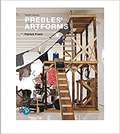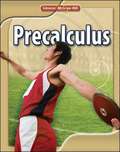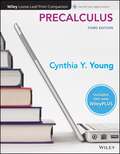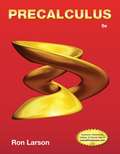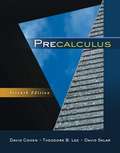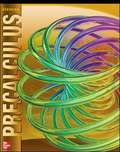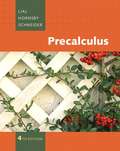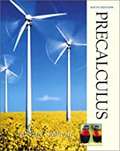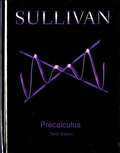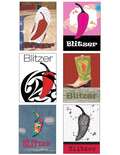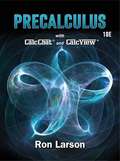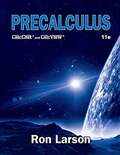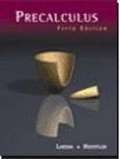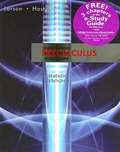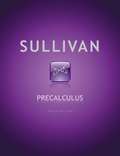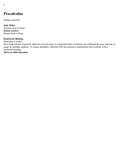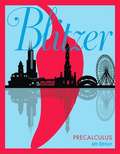- Table View
- List View
Prebles' Artforms
by Patrick FrankWe form art. Art forms us. The title of this book has a dual meaning. As humans form works of art, we in turn are formed by what we have created. Such human creativity influences and stimulates us. Several editions ago, this book's title was changed to Prebles' Artforms, acknowledging the pioneering contribution of the original authors, Duane and Sarah Preble. They first posited the emphasis on our two-way interaction with works of art, and that emphasis continues to inform every page of this book. Why study art? Because artists have dealt at one time or another with nearly every aspect of the human experience, from the common to the forbidden, the mundane to the sacred, the repugnant to the sublime. Artistic creativity is a response to being alive, and by experiencing such creativity, we enrich our experience of life. Behind all of the learning objectives, new terms, quizzes, flashcards, and writing prompts that accompany this book, there is a wealth of visual creativity that has constantly informed, surprised, inspired, challenged, or thrilled by Patrick Frank.
Precalculus
by Bernard Kolman Arnold Shapiro Michael L LevitanPrecalculus: A mathematics/statistics textbook
Precalculus
by Day Carter CuevasGlencoe Precalculus ©2011is a comprehensive program that prepares students to be successful in college or AP Calculus programs. Features of this program include: Chapter 0, Graphing Technology Labs, leveled exercise sets, H. O. T. (Higher-Order Thinking) Problems, and Preparation for AP Calculus lessons within every chapter. Glencoe Precalculusalso includes a complete technology suite that contains an online student edition, online teacher edition, Interactive Classroom, Advance Tracker, andExamView® Assessment Suite.
Precalculus
by Cynthia Y. YoungPrecalculus was developed to create a program that seamlessly align with how teachers teach and fully supports student learning. Cynthia Young’s goal was to create an intuitive, supportive product for students without sacrificing the rigor needed for true conceptual understanding and preparation for Calculus. Precalculus helps bridge the gap between in-class work and homework by mirroring the instructor voice outside the classroom through pedagogical features.
Precalculus
by Ron Larson David C. FalvoLarson's market-leading text, PRECALCULUS is known for delivering sound, consistently structured explanations and exercises of mathematical concepts to expertly prepare students for the study of calculus. With the ninth edition, the author continues to revolutionize the way students learn material by incorporating more real-world applications, ongoing review, and innovative technology. How Do You See It? exercises give students practice applying the concepts, and new Summarize features, Checkpoint problems, and a Companion Website reinforce understanding of the skill sets to help students better prepare for tests.
Precalculus
by David Sklar David Cohen Theodore B. LeeGet a good grade in your precalculus course with PRECALCULUS, Seventh Edition. Written in a clear, student-friendly style, the book also provides a graphical perspective so you can develop a visual understanding of college algebra and trigonometry. With great examples, exercises, applications, and real-life data--and a range of online study resources--this book provides you with the tools you need to be successful in your course.
Precalculus
by Glencoe McGraw-Hill StaffGlencoe Precalculus ©2011is a comprehensive program that prepares students to be successful in college or AP Calculus programs. Features of this program include: Chapter 0, Graphing Technology Labs, leveled exercise sets, H. O. T. (Higher-Order Thinking) Problems, and Preparation for AP Calculus lessons within every chapter. Glencoe Precalculus also includes a complete technology suite that contains an online student edition, online teacher edition, Interactive Classroom, Advance Tracker, and ExamView® Assessment Suite.
Precalculus
by Margaret L. Lial John Hornsby David I. Schneider Callie J. DanielsOver the years, the text has been shaped and adapted to meet the changing needs of both students and educators. As always, special care was taken to respond to the specific suggestions of users and reviewers through enhanced discussions, new and updated examples and exercises and helpful features. The result is an easy-to-use, comprehensive text that is the best edition yet.
Precalculus
by Michael SullivanA proven motivator for readers of diverse mathematical backgrounds, this book explores mathematics within the context of real life using understandable, realistic applications consistent with the abilities of any reader. Graphing techniques are emphasized, including a thorough discussion of polynomial, rational, exponential, and logarithmic functions and conics. Includes Case Studies; New design that utilizes multiple colors to enhance accessibility; Multiple source applications; Numerous graduated examples and exercises; Discussion, writing, and research problems; Important formulas, theorems, definitions, and objectives; and more. For anyone interested in precalculus.
Precalculus
by OpenStaxPrecalculus is intended for college-level Precalculus students. Since Precalculus courses vary from one institution to the next, we have attempted to meet the needs of as broad an audience as possible, including all of the content that might be covered in any particular course. The result is a comprehensive book that covers more ground than an instructor could likely cover in a typical one- or two-semester course; but instructors should find, almost without fail, that the topics they wish to include in their syllabus are covered in the text. Many chapters of Openstax Precalculus are suitable for other freshman and sophomore math courses such as College Algebra and Trigonometry; however, instructors of those courses might need to supplement or adjust the material. Openstax will also be releasing a College Algebra and Trigonometry title tailored to the particular scope, sequence, and pedagogy of those courses.
Precalculus
by Ron LarsonThe tenth edition of PRECALCULUS gives you clear explanations of math concepts, examples and exercises that relate to everyday life, and innovative technology to help you study and practice when and where you want. "How Do You See It?" exercises let you practice applying the concepts, and new "Summarize" features and "Checkpoint" problems reinforce your understanding of the skills you need to better prepare for tests.
Precalculus
by Ron LarsonLarson's PRECALCULUS is known for delivering sound, consistently structured explanations and carefully written exercises of mathematical concepts. <p><p>Updated and refined through learning design principles, the 11th Edition removes barriers to learning and offers a carefully planned and inclusive experience for all students. New Review and Refresh exercises prepare students for each section and provide a general skill review throughout the text. How Do You See It? exercises give students practice applying the concepts, and new Summarize features, and Checkpoint problems reinforce understanding of the skill sets to help students better prepare for tests. Larson’s learning support includes free text-specific tutorial support at CalcView.com and CalcChat.com.
Precalculus (5th edition)
by Ron Larson Robert P. HostetlerThis comprehensive book provides complete coverage of the function concept and integrates substantial graphing calculator materials that help students develop insight into mathematical ideas.
Precalculus (7th Edition)
by Ron Larson Robert Hostetler David C. FalvoThe authors use precise mathematical language and a clear writing style to develop an effective learning tool for students. Solutions to examples are derived side by side - algebraically, graphically, and numerically.
Precalculus (9th Edition)
by Michael SullivanMike Sullivan's time-tested approach focuses students on the fundamental skills they need for the course: preparing for class, practicing with homework, and reviewing the concepts. In the Ninth Edition, Precalculus has evolved to meet today's course needs, building on these hallmarks by integrating projects and other interactive learning tools for use in the classroom or online.
Precalculus (A/P Precalculus)
by Julie MillerParamount to the development of Precalculus was the invaluable feedback provided by the teachers from around the country who reviewed the manuscript or attended a market development event over the course of the several years the text was in development.
Precalculus (Second Edition)
by Robert BlitzerDesigned to help students transition from intermediate algebra to calculus in the process helping students enhance their problem solving skills and become critical thinkers as they tackle real world problems
Precalculus (Sixth Edition)
by Robert BlitzerWith the new edition, Blitzer takes student engagement with the mathematical world to a whole new level drawing from applications across all fields as well as topics that are of interest to any college student (e.g., student loan debt, grade inflation, sleep hours of college students). Applications are also brought to life online in a new, assignable video series that explore the entertaining and mathematical Blitzer Bonus boxes. The new edition also aims to help more students to succeed in the course with just-in-time support in the text--such as Brief Review of prerequisite topics, Achieving Success boxes, and Retain the Concepts exercises--as well as support within MyLab™ Math such as new concept-level videos, assignable tools to enhance visualization, and more.
Precalculus Concepts through Functions Fourth Custom Edition for Jamestown Community College
by Michael SullivanPrecalculus Concepts through Functions Fourth Custom Edition for Jamestown Community College
